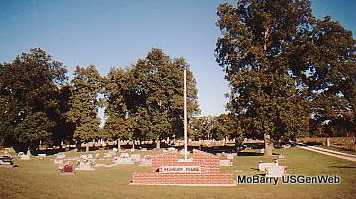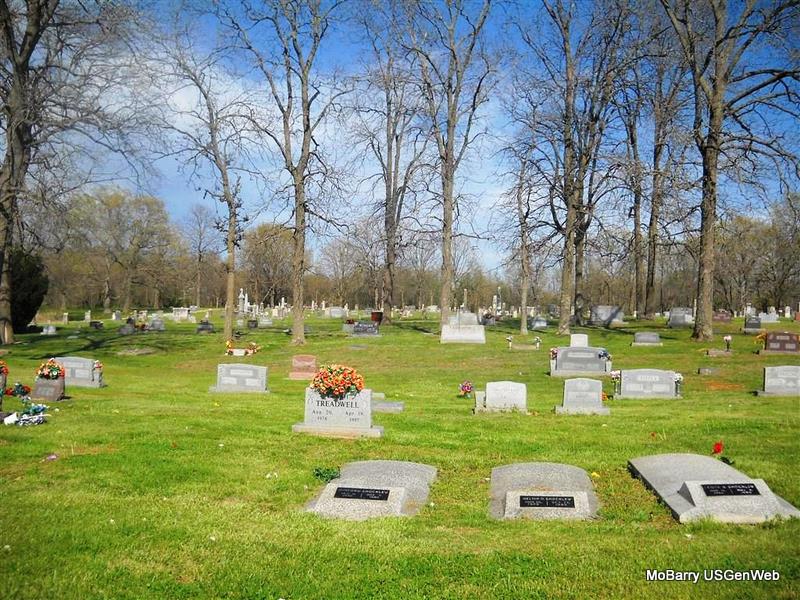Washburn Prairie Cemetery AKA Prairie
Washburn, Barry Co., MO
Sugar Creek Twp.
Land Office Location - SW Sec. 26, T22N, R28W
GPS - 363523N 0935552W
Sugar Creek Twp.
Land Office Location - SW Sec. 26, T22N, R28W
GPS - 363523N 0935552W


Directions: Take 112 South out of Cassville, MO about 6.5 miles from city limits, turn right on Highway AA go 6.7 miles. The cemetery is on the left. Or you can take Highway 37 South out of Cassville, MO for 7 miles to Washburn city limits. Turn left on Farm Road 2240 (Washburn Prairie Road) and go 1.2 miles. The cemetery is on the right. Phyllis Long and Donna Cooper took the photos for this cemetery in the summer of 2009. All the known stones were photographed at that time.
Donations for regular maintenance can be sent to Freedom Bank of Southern MO, 97 South Main Street, Cassville, MO 64625
Photos Submitted by Phyllis Long and Donna Cooper
The oldest grave found here was for Godfrey Toler who died in 1843. Another old one was for Joseph Routh - aka: Ruth - who died in 1848. Those two graves are located in the old section and are not too far from one another. There could have been other people buried here about that time who no longer have stones or perhaps may never have had stones.
There are many unmarked graves and several graves with fieldstone markers and there are also some slave graves here, too.
There are many stones that are broken and several that are on the ground and that are in need of repair.
The problem is that some of the early day settlers left the county and so in some cases there may not be any relatives left in the county to make cemetery stone repairs; therefore Barry County families are urged to pay attention to these needs and to help us to save our cemetery history by repairing some of these stones.
Before the Civil War there were a substantial number of slaves in Barry County. To know just how many check the slave schedules in the census for those decades.
Mary Carr, who for several years, kept the records for Washburn Prairie Cemetery, told how slave burials were handled there. The slaves came to the Church elders who ran the cemetery asking to bury their people. The request was approved, with the proviso that they were not to use the same kind of monument that the whites used.
They accomplished that by cutting heavy slabs of sandstone and erecting an above-ground monument with sloping sides. These edifices were placed at what was then the back side of the cemetery, farthest from the road. And, they are a distinctly different style.
The sandstone used is far more durable and weather-resistant than the pretty marble and limestone monuments used by their masters.
Stop by Washburn Prairie Cemetery someday to see them. You need not hurry because they are some of the most durable stones in the cemetery and will be there a long time.
Visit Washburn Cemetery Files
Yard Shot
Yard Shot
Yard Shot - Looking South - Newer Section
Yard Shot - Looking South - Newer Section
Yard Shot - Looking South - Newer Section
Yard Shot - Looking North - Toward Shed
Yard Shot - Looking West in Newer Part
Yard Shot in Newer Part - Looking East
Yard Shot - From Middle
Yard Shot - Looking East
Yard Shot - Looking West
Yard Shot - Looking West
Yard Shot - Looking West
Yard Shot - Looking West
Yard Shot - Looking West
Yard Shot Northeast Corner - Looking South
Slave Graves
Shot Looking Across Slave Graves
Slave Graves
Slave Graves
Yard Shot
Yard Shot
Yard Shot
Gerald Haddock and Dane Martin (both deceased)
Gerald Haddock (deceased)
Barbara Erwin a nice Plat Map
Yard Shot
Yard Shot
Yard Shot - Looking South - Newer Section
Yard Shot - Looking South - Newer Section
Yard Shot - Looking South - Newer Section
Yard Shot - Looking North - Toward Shed
Yard Shot - Looking West in Newer Part
Yard Shot in Newer Part - Looking East
Yard Shot - From Middle
Yard Shot - Looking East
Yard Shot - Looking West
Yard Shot - Looking West
Yard Shot - Looking West
Yard Shot - Looking West
Yard Shot - Looking West
Yard Shot Northeast Corner - Looking South
Slave Graves
Shot Looking Across Slave Graves
Slave Graves
Slave Graves
Yard Shot
Yard Shot
Yard Shot
Gerald Haddock and Dane Martin (both deceased)
Gerald Haddock (deceased)
Barbara Erwin a nice Plat Map

